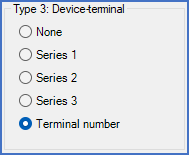|
<< Click to Display Table of Contents >> Type 3: Device-terminal |
  
|
|
<< Click to Display Table of Contents >> Type 3: Device-terminal |
  
|

Figure 481: The type 3 section
Here you choose how wires of connection type 3 should be numbered. Connection type 3 refers to wires between a device and a terminal.
You can choose between five different options. The first is not to number these wires at all. The three following options are to use one of three available numbering series that are defined in the numbering series section. The last option is to use the terminal number of the terminal to which the wire is connected as wire number.
So, besides the possibility to use numbering series for wire numbering, as for wires of connection types 1 and 2, there is an additional option available for wires to terminals, namely to use the terminal number as wire number.
In the type 3 section, you specify how wires between devices and terminals should be numbered. All available options are described in the table below.
Option |
Description |
|---|---|
None |
Wires of connection type 3 will not be numbered, meaning that the wire number will be left empty.
|
Series 1
|
Wires of connection type 3 will be numbered using numbering series 1, which is defined in the Numbering series for wires section, parameters Series 1 / Start value and Series 1 / Step value.
|
Series 2
|
Wires of connection type 3 will be numbered using numbering series 2, which is defined in the Numbering series for wires section, parameters Series 2 / Start value and Series 2 / Step value.
|
Series 3
|
Wires of connection type 3 will be numbered using numbering series 3, which is defined in the Numbering series for wires section, parameters Series 3 / Start value and Series 3 / Step value.
|
Terminal number |
Wires of connection type 3 will be numbered using the terminal number from the terminal to which it is connected.
This numbering system can, however, lead to ambiguities. In some cases it may result in several wires with the same number in the same wire chain (electrical sub-node). If that happens, several problems follow. Among them is that future renumbering will be prevented, since the existing numbers will be considered erroneous.
For that reason, an additional feature is available, which guarantees that wire numbers within the same wire-chain are always unique. This is accomplished by adding a prefix to the wire number when needed. If two wires were to receive the same number, a suffix is appended to the end of the second one.
If, for example, numbering according to Terminal number would result in three wires within the same wire-chain, all with the same wire number of 100, those wires would instead be numbered 100, 100.1 and 100.2. This suffix feature is controlled by the Suffix to separate identical numbers in the same node parameter.
If you use that feature, all generated wire numbers will become unambiguous within each wire-chain, resulting in an error-free numbering, which in turn enables features like revision comparisons and renumbering of wires.
|